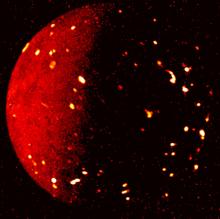Listen to today's episode of StarDate on the web the same day it airs in high-quality streaming audio without any extra ads or announcements. Choose a $8 one-month pass, or listen every day for a year for just $30.
You are here
More Moon, Venus, Jupiter
The Moon and the planet Jupiter stage a spectacular encounter this evening. Jupiter looks like a brilliant star next to the Moon. Venus, the “evening star,” is close below them, completing an impressive tableau.
Jupiter has four big moons of its own. And a spacecraft that’s been orbiting Jupiter since 2016 has recently turned its instruments toward three of them.
The biggest is Ganymede — the largest moon in the entire solar system. The Juno spacecraft flew just 650 miles from it in June of 2021 — the closest encounter with Ganymede in almost two decades.
Juno confirmed the moon has a deep ocean buried far below its icy surface. It also provided new details on Ganymede’s innards, and on the composition and temperature of some of its surface features.
Juno made a close pass by the moon Europa early last year. Europa has a buried ocean, too. But it’s much closer to the surface, and it’s considered a possible habitat for life. Scientists are still analyzing those observations.
And in December, Juno made the first of nine encounters with Io. It’s the smallest of the four big moons. Instead of ice and water, it’s a world of volcanoes — more than any other body in the solar system. Juno will pass less than a thousand miles from Io a couple of times.
The craft will continue its reconnaissance of Jupiter as well — telling us more about the solar system’s largest planet.
More about the Moon and its companions tomorrow.
Script by Damond Benningfield






